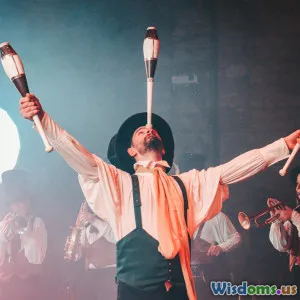
Surprising Truths Behind Fictional Characters’ Popularity
9 min read Exploring surprising psychological, cultural, and storytelling reasons behind fictional characters’ enduring popularity worldwide. (0 Reviews)
Surprising Truths Behind Fictional Characters’ Popularity
Fictional characters often become much more than just elements in a story — they evolve into cultural icons, embodying values, ideals, or emotions that resonate deeply with audiences across the globe. We all know the household names: Harry Potter, Sherlock Holmes, Spider-Man... but do we truly understand why they captivate millions? This article peels back the layers to reveal surprising truths behind why fictional characters capture hearts, minds, and imaginations like few other creations can.
Introduction: Beyond Entertainment
At first glance, the popularity of fictional characters might seem as straightforward as engaging storytelling or stellar visual design. However, behind these surface elements lies a complex interplay of psychology, culture, and social identity that propels some characters from mere plotshares to lasting emblems in popular culture.
Understanding these hidden factors not only enriches our appreciation of fiction but also offers valuable insights for creators, marketers, and fans alike on what makes a character truly memorable.
The Psychological Pull: Archetypes and Relatability
Archetypes as Universal Language
One of the most powerful drivers behind character popularity is rooted in the psychology of archetypes — universal, archaic patterns and images that reside in the collective unconscious, as Carl Jung described.
Characters tapping into archetypes like the Hero, the Mentor, the Rebel, or the Innocent resonate deeply because they reflect fundamental human experiences and aspirations. For example, Katniss Everdeen’s rebellious spirit in "The Hunger Games" taps into the archetype of the Outlaw or the Revolutionary, which appeals to our innate desire for freedom and justice.
These archetypes act as psychological shorthand, allowing audiences from different backgrounds to relate instantly.
Emotional Resonance and Vulnerability
Popularity also spikes when characters display tangible vulnerabilities alongside their strengths. Characters that seem invincible but lack emotional depth risk becoming unrelatable. Consider Tony Stark (Iron Man), whose charisma is amplified by his struggles with insecurity and addiction, providing multidimensionality that fans connect with authentically.
A study published by the Journal of Media Psychology found that viewers form emotional bonds with fictional characters that demonstrate a blend of admirable traits and relatable flaws. This blend creates empathy, fueling the character's long-term appeal.
Storytelling Mechanics: Complexity and Narrative Role
Compelling Character Arcs
Characters that evolve significantly through the story tend to stand out more. Dynamic characters showing growth or transformation feel like real entities undergoing meaningful journeys, which audiences find rewarding.
Consider Walter White from "Breaking Bad": his journey from a mild-mannered teacher to a ruthless drug kingpin fascinates viewers because it challenges our moral expectations and portrays complex motives.
Narrative Importance and Screen Time
Naturally, the more integral a character is to the plot, the more memorable they become. However, it’s not just quantity but quality of interaction that matters. Supporting characters like Samwise Gamgee in "The Lord of the Rings" shine because their loyalty and unwavering support create a strong emotional tether to the protagonist and audience.
A 2016 analysis of top-rated TV shows by ScreenRant showed that characters with balanced screen time and clear narrative importance were significantly more likely to gain fan followings.
Cultural and Social Factors: Representation and Identity
Cultural Resonance and Timeliness
The popularity of characters is often fueled by the socio-cultural context in which they appear. Characters who mirror contemporary social issues or represent marginalized groups can become powerful symbols.
Take Black Panther, whose 2018 film challenged traditional superhero tropes and celebrated African culture, becoming a major cultural milestone. Its breakout lead, T’Challa, wasn’t just a character but a source of pride, empowerment, and representation for millions worldwide.
Identification and Aspirational Influence
Fictional characters often serve as vessels through which people explore their own identities and aspirations. For adolescents, characters navigating similar life challenges serve as role models or expressions of inner conflict.
Zelda Fitzgerald, wife of the famed American writer F. Scott Fitzgerald, famously said, "What is a hero? A man who does what he cannot do."
Characters that embody qualities viewers wish to cultivate—bravery, integrity, resilience—become aspirational figures. Ariel from Disney’s "The Little Mermaid," for example, resonates because of her desire to explore and break free from constraints.
Marketing and Media Influence: Constructing Icons
Media Saturation and Merchandising
Behind every popular character is a multifaceted marketing strategy reinforcing their presence across media platforms—movies, TV shows, video games, toys, and social media.
Character ubiquity boosts popularity exponentially. Mickey Mouse, originating in 1928, benefited immensely from merchandising and theme parks, keeping the character alive in the public imagination for almost a century.
Fan Communities and Social Media
Digital platforms allow fans to form communities, creating, sharing, and celebrating character content. This participatory culture amplifies character appeal well beyond traditional media.
Fan fiction, cosplay, and social media fan pages turn characters into living cultural phenomena. The "Star Wars" fandom, with its extensive lore discussions and conventions, exemplifies how community engagement sustains popularity.
This ongoing dialogue between creators and fans often influences character development and longevity.
Conclusion: The Multifaceted Formula of Popularity
Fictional characters’ popularity is rarely accidental or solely based on plot or design. Instead, it emerges from a rich tapestry of psychological archetypes, empathetic storytelling, cultural representation, and strategic media proliferation.
Characters who succeed in speaking to universal human experiences, embody relevant cultural identities, evolve compelling narratives, and harness modern marketing tools secure their place in popular culture.
For readers and creators alike, recognizing these layers goes beyond passive enjoyment—it opens possibilities for deeper engagement and the creation of characters that resonate across generations.
Final Thought: Next time you root for a beloved character, consider the unspoken dynamics that amplify your connection. Understanding these truths elevates fandom into a celebration of human creativity, identity, and storytelling mastery.
References
- Jung, Carl G. The Archetypes and The Collective Unconscious. Princeton University Press.
- Nazemi, S., & Kaski, K. (2020). Emotional Bonding with Fictional Characters: The Psychological Impact. Journal of Media Psychology, 32(1), 45-57.
- Green, M. C., & Brock, T. C. (2000). The Role of Transportation in the Persuasiveness of Public Narratives. Journal of Personality and Social Psychology, 79(5), 701–721.
- ScreenRant. (2016). How Screen Time Affects Character Popularity in TV Shows.
- Disney’s Marketing Case Study: Mickey Mouse – The Power of Iconic Character Branding
Rate the Post
User Reviews
Popular Posts



















